Monarch Butterfly Migration Over Central
Iowa
Fall 2008
By Robert D. Woodward
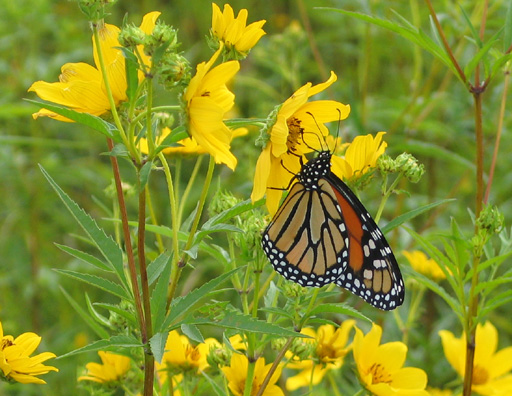
Tickseed Sunflowers Are Favorites of Migrating Monarchs
In late August, only a few migrating monarch butterflies were being observed during visits to Neal Smith National Wildlife Refuge near Prairie City, where fall visits often turn up substantial numbers of the butterflies on the move. At home, in our butterfly garden in Altoona, Iowa, five to 10 monarchs were being seen daily.
August 28--Three monarchs were noted during an hour visit to Neal Smith refuge.
August 31--The day was clear and sunny with morning temperatures in the 60s at the Neal Smith refuge. On this day, 11 monarchs were counted during a morning visit of nearly two hours. In the years 2005, 2006 and 2007, the early movement of the fall migrations tended to be indicated during the period of August 31 and September 1.
September 2--Six monarchs were noted at Neal Smith refuge during an hour in the early afternoon. The temperature was in the 80s, and a strong breeze was blowing from the south southwest.
September 4--During a mid-afternoon visit to Neal Smith refuge, five monarchs were noted in 45 minutes.
September 5--A dense fog was hanging over central and northern area as the the morning began. The temperature was in the low 50s, and a light breeze was blowing when we arrived at Neal Smith refuge shortly before 9 a.m. There was no sign of migrating monarchs in the northern part of the refuge. But as the fog lifted in the first hour, we moved to the refuge's savanna trail area where the open prairie meets a hillside stand of oak trees. Suddenly, the monarchs started showing up along the trail as they flew down from the oak trees where they apparently had taken refuge during the night. What we observed over the next hour and one-half was a spectacular showing of migrating monarchs as they flew out across the prairie and were found nectaring on wildflowers in areas amid the stand of oak trees. By the end of the morning, we had counted at least 250 monarchs, but the numbers surely were greater. This was another of those "monarch moments" when the beauty of nature creates a breathtaking environment.
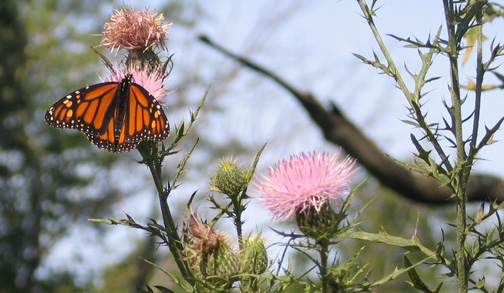
A Monarch Nectars on a Thistle in Wooded Surroundings
When we returned to our home in Altoona, Iowa, some 15 miles west of the Neal Smith refuge, we were in for another surprise from nature. As many as 30 migrating monarchs had stopped off in our butterfly garden. They were nectaring on goldenrod and cup plants and resting on the leaves of Jerusalem artichoke plants and a hazelnut bush. They were flying around and in and out of the garden. Within an hour after putting on a great show, they left, and one might never know they had been there--except for some digital photographs.
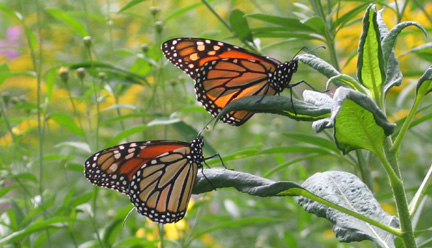
Two Migrating Monarchs Rest on a Jerusalem Artichoke Plant
September 6--The morning started out slowly because of another dense fog over two-thirds of Iowa's 99 counties. In the first hour beginning at 9:30 a.m. at Neal Smith National Wildlife Refuge near Prairie City, no migrating monarchs were observed. But in the late morning as the sun broke through the fog and clouds, monarchs began moving out of their secluded areas to nectar on the wildflowers--especially the tickseed sunflowers. The tickseeds are a favorite nectaring source each fall for a period of 7 to 10 days as their blooming period coincides with the monarchs' migration south. Shortly after noon in the northern part of the refuge, a wave of monarchs began showing up amid the tickseeds in that area. More than 100 were counted in a short time as they flew from flower to flower. Overall during the morning visit, more than 225 monarchs were counted--another clear indicator the fall migration was under way.
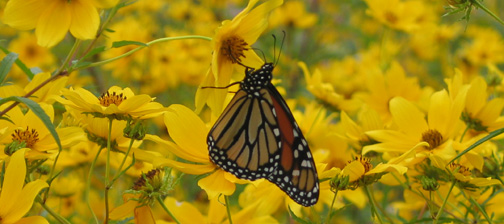
A Monarch Enjoys the Tickseed Stopping Point
September 7--The morning was sunny, and the temperature was in the 50s--a great day for monarch movement at Neal Smith National Wildlife Refuge. Monarchs were spotted in various parts of the refuge, and tickseed sunflowers continued to be the most popular source for nectaring by the butterflies. In the late morning, migrating monarchs once again were arriving in the northern part of the refuge, and they were spending their time flying around and nectaring in a large area of tickseeds. In another area, 10 or so monarchs were enjoying the rough blazingstar for their nectaring. During the morning, 406 monarchs were counted--the largest to date this fall.
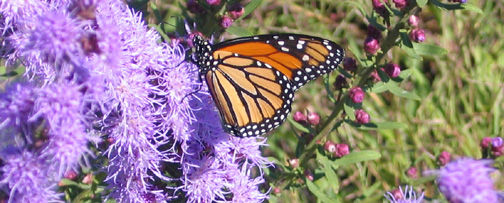
Rough Blazingstar is an Attraction for a Monarch
September 8--A rainy day dampened the possibilities of monarch movement. Tonight the temperature is predicted to be in the low 40s so the monarch migration may be accelerated tomorrow.
September 9--This was a wonderful day for observing migrating monarch butterflies. On Monday, their movement had been dampened by rainy weather, but things changed. This day began with temperatures across central Iowa in the 40s, but the sunny weather stirred up monarch movement once again. During two hours of observations at Neal Smith National Wildlife Refuge, we counted the largest total yet for this fall--545 monarchs. In the first 30 minutes, we counted about 250 monarchs nectaring on tickseeds in the northern edge of the refuge. What a delight to see them racing here and there over the wildflowers.
September 10--Monarch migration was continuing, although the butterflies were dealing with a strong wind from the east southeast at Neal Smith National Wildlife Refuge. Once again, the monarchs were visiting the tickseed sunflowers in the north of the refuge. A number of them could be seen racing with the wind over the flowers. More of them now were choosing alternatives such as goldenrod and thistles for their nectaring. In an hour and 50 minutes in mid-afternoon, we counted 225 monarchs.

Tickseeds Continue to Attract the Monarchs
September 11--Rain had fallen, and a light mist was dampening the area in Neal Smith National Wildlife Refuge. But as the mist subsided around 11 a.m., monarchs began flying over the tickseeds in the north of the refuge. The sun began coming out from behind the clouds, and monarch activity picked up. By noon, 100 monarchs were observed, and then in the early afternoon, the pace of movement picked up considerably in other parts of the refuge. In three hours of observing, 300 monarchs were noted--providing a lesson on how the butterflies deal with moisture, strong winds, sunlight, and clouds.
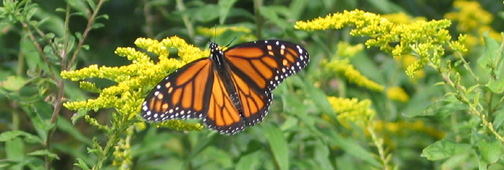
A Monarch Finds the Goldenrod for Nectaring
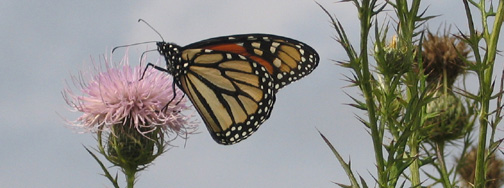
Thistles Also Are Welcoming the Visitors
September 13--Following a day and one-half of rainy weather, we visited Neal Smith National Wildlife Refuge in the late afternoon looking for monarchs, and we found them. The day was cloudy, but we began seeing some monarch activity in the north of the refuge. To the south where the prairie meets oak woods on a hillside near the savanna trail, we discovered monarchs flying out from the oaks to nectar of the prairie wildflowers. Then they returned to several roosts on the hillside oak trees. Great viewing. We counted 190 monarchs, but the numbers in the roosting areas surely were higher as the monarchs were swirling around our heads and stopping on the oak branches.
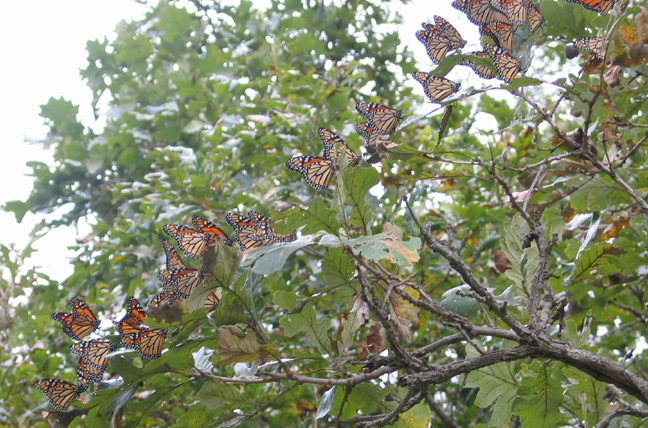
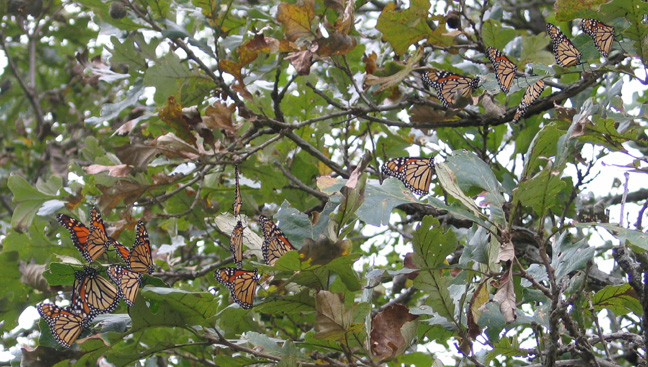
Monarchs Find Places to Roost in the Oak Trees
September 14--Three hours of morning observations turned up 220 monarch butterflies--many of which were dealing with a strong northwest wind of 20 to 30 miles an hour. The monarchs were stopping on oak trees in the south of Neal Smith National Wildlife Refuge, and struggling across the prairie for nectaring on wildflowers. The sun came out from behind the clouds for a time, and the monarch activity picked up. While observing the monarchs, I found one caught in a spider web. I took it out of the web, cleaned its wings of the webbing, held it up to the sky, and watched it fly hundreds of feet up to the top of an oak tree!
September 15--A sunny day on the prairie brought out strong monarch activity at Neal Smith National Wildlife Refuge. Most of the monarchs appeared to be moving away from their favorite wildflowers of the past week--tickseed sunflowers, and were turning instead to sawtooth sunflowers for their nectaring. During three hours of observation in the afternoon, 384 monarchs were counted--especially on the taller sawtooth sunflowers.
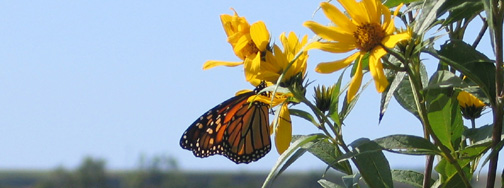
A Monarch Visits a Sawtooth Sunflower
September 16--The day was mild and sunny, and it was a welcome environment for migrating monarch butterflies. They were continuing to be quite active at Neal Smith National Wildlife Refuge. During four hours of observations in the late morning and early afternoon, 510 monarchs were counted. In one area of sawtooth sunflowers, nearly 150 monarchs were observed in one-half hour moving from flower to flowers and hanging on to the blossoms while a light wind moved the plants to and fro.
September 17--The mild weather is continung across central Iowa and is predicted to do so through the end of the week. On this Wednesday, the temperature was around 80 degrees, and a light breeze was blowing at Neal Smith National Wildlife Refuge. The monarch butterflies were enjoying the day. In an hour and one-half observation between 2 p.m. and 3:30 p.m., 306 monarchs were counted. They continued to favor sawtooth sunflowers for their nectaring. Only a single monarch was noted nectaring on the earlier-favored tickseed sunflowers.
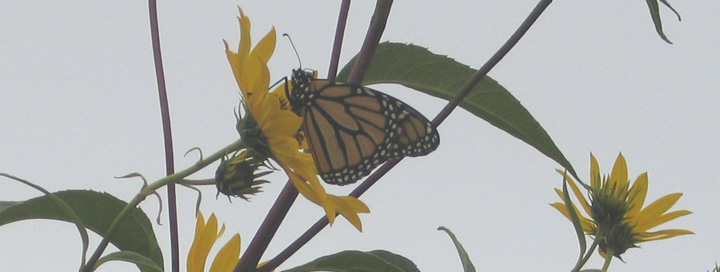
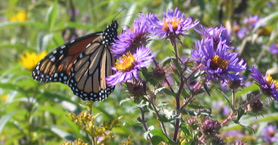
Sawtooth Sunflowers, Purple Asters Provide the Nectar
September 18--Today was an amazing time for observing migrating monarch butterflies at Neal Smith National Wildlife Refuge. As we entered the refuge, we noted monarchs moving in from the north and stopping to nectar on sawtooth sunflowers. We counted 125 monarchs in 15 minutes. The monarchs were seen, too, in many other areas of the refuge, floating across the landscape, flying quickly from place to place, and seeking nectar primarily on sawtooth sunflowers. During 3 1/2 hours of observations in late morning and early afternoon, we counted 1240 monarchs--the most yet by far during daily visits to the refuge.
September 19--Friday was another banner day for viewing the movement of the migrating monarch butterflies at Neal Smith National Wildlife Refuge. The mild, sunny weather continued to foster a strong migratory pattern, although a wind from the south southeast slowed some of the monarchs' movements. During 3 hours of observations, 540 monarchs were counted.
September 20--Migrating monarch butterflies continued to pour in from the north at Neal Smith National Wildlife Refuge. In a half hour starting at 9 a.m., we counted more than 350 monarchs coming in to nectar in stands of sawtooth sunflowers and flying and floating across the big bluestem grasses. The day was calm, sunny, and warm, and monarchs were spotted elsewhere, too, in significant numbers in the refuge. During 3 1/2 hours of observation, we counted 1002 monarchs.
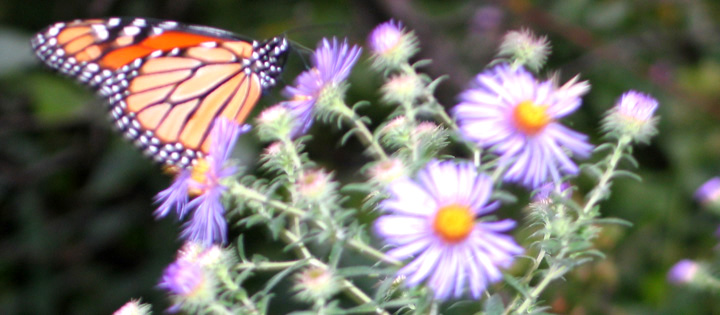
The Beauty of the Migration--Monarchs and Asters
September 21--Monarch butterflies continued to fly in from the north at Neal Smith National Wildlife Refuge. During nearly four hours of observations in the morning, 527 monarchs were counted. In addition to the movement in from the north, a number of monarchs appeared to be coming up out of the big bluestem grasses where they had spent the night. Back home in our butterfly garden in Altoona, 10 monarchs put on a beautiful show in the afternoon when nectaring together on the purple asters.
September 22--A strong wind was blowing from the south, and the skies were cloudy at Neal Smith National Wildlife Refuge. Drops of rain had occasionally been falling. During one hour of observations in the afternoon, we saw few monarchs--especially when compared with large numbers in the previous days. Eleven monarchs were counted. Later, in our butterfly garden, 10 monarchs were noted nectaring on asters and resting on branches of mountain ash and oak trees.
September 23--A strong southerly wind was slowing the movement of monarchs at Neal Smith National Wildlife Refuge. During an hour of observation in the morning, 16 monarchs were noted. Back home in our butterflly garden, 15 monarchs were noted in our butterfly garden between 8:30 a.m. and 9 a.m. Then in the afternoon, some 40 monarchs were seen coming in from the north to stop in the garden for nectaring.
September 25--On a mild, sunny day at Neal Smith National Wildlife Refuge, we counted 110 monarchs during a visit of an hour and one-half. Single monarchs were seen flying in from the north at a rate of about one or two a minute. Another 30 monarchs were noted along the central Iowa roadways to and from the refuge, and in our butterfly garden, monarchs continued to fly in from the north throughout the day.
September 26--Compared to observations in recent years, the monarch butterfly migration appears to be continuing heavier in late September than in years past. Observations on this Friday indicated numerous monarchs making their way south over central Iowa. At Neal Smith National Wildlife Refuge, we counted 92 monarchs flying in from the north in an hour and 20 minutes in the late morning. Another 45 monarchs were observed along the roadways to and from the refuge. In our butterfly garden, monarchs were seen stoppng off throughout the day for nectaring. A sunny and mild day aided the monarch activity.
September 27--For this late in the season, a surprising number of monarch butterflies continued their migration over central Iowa. In our first hour of observation from 9:20 a.m. to 10:20 a.m. at Neal Smith National Wildlife Refuge, we noted 170 monarchs flying south over the big bluestem grasses and wildflowers in the northern part of the refuge. Most of the butterflies were singles, and only one stopped on a wildflower. The day was mild and clear so many of the monarchs were flying--and then floating--over the landscape. In two hours of observations, we counted 266 monarchs. Other monarchs were noted on the central Iowa roadways and in our butterfly garden.
September 28--A dense fog was covering central Iowa, reducing the possibility that many migrating monarchs would be on the move. Two monarchs were noted in the first morning hour at Neal Smith National Wildlife Refuge. The fog cleared in the second hour; the day was cloudy. No more monarchs were noted.
September 29--A strong wind was blowing from the northwest during an afternoon visit to Neal Smith National Wildlife Refuge. No signs of monarch movement were noted during one-half hour of observation.
September 30--Strong winds from the northwest continued at Neal Smith National Wildlife Refuge. No monarchs were seen in one-half hour in the morning.
October 1--All indications are that the monarch butterfly migration has ended over central Iowa.
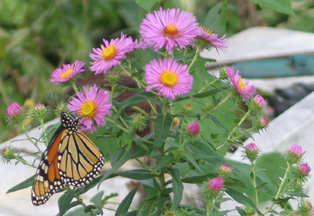
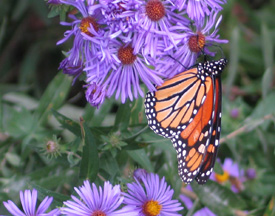
Pink or Purple Asters? The Monarchs Have Their Choices